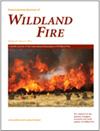数据驱动的野地火灾蔓延预测中的异步观测分布式策略
IF 2.9
3区 农林科学
Q1 FORESTRY
引用次数: 0
摘要
背景 非同步观测是指在多个时刻获得的观测数据。在整个野火区,火锋的观测时刻可能各不相同。异步观测包括历史数据,由于缺乏对不断变化的火锋的及时更新,这阻碍了数据同化的有效性。本文针对异步观测提出了一种与集合变换卡尔曼滤波器(ETKF-distributed)相结合的分布式策略。通过使用预测与观测之间的新匹配方案,它可以立即同化任何地点的火锋。方法 根据当地真实地形、植被和历史气象数据生成的野地火灾对分布式 ETKF 进行了测试。此外,我们还采用了先前工作中提出的 ETKF 和集中式 ETKF 作为对比。进行了观测系统模拟实验,以生成异步观测火锋。主要结果 即时同化的优势使新方法能够保持较高的预测精度。结论 采用 ETKF 分布法时,观测资源的分配可以集中在速度快的区域。意义 ETKF 分布式具有高效率和高适应性,因此在野火预测中很有应用前景。本文章由计算机程序翻译,如有差异,请以英文原文为准。
The distributed strategy for asynchronous observations in data-driven wildland fire spread prediction
Background Asynchronous observations refer to observations that are obtained at multiple moments. The observation moments of fire fronts may differ throughout an entire wildfire area. Asynchronous observations include historical data, which hinders the effectiveness of data assimilation due to the lack of timely updates on changing fire fronts. Aims This paper proposed a distributed strategy combined with the Ensemble Transform Kalman filter (ETKF-distributed) for asynchronous observations. It can assimilate fire fronts immediately at any location by using new matching schemes between prediction and observation. Methods The ETKF-distributed undergoes testing using a wildland fire generated based on real terrain, vegetation, and historical weather data from the local area. In addition, the ETKF and ETKF-centralised proposed in our previous work were employed as comparisons. Observing System Simulation Experiments were conducted to generate asynchronous observation fire fronts. Key results The benefit of immediate assimilation enables the new method to maintain high accuracy predictions. Conclusions The allocation of observation resources can be focused in regions with high rates of speed when employing ETKF-distributed. Implications The ETKF-distributed has high efficiency and adaptability, making it highly promising for implementation in wildfire prediction.
求助全文
通过发布文献求助,成功后即可免费获取论文全文。
去求助
来源期刊
CiteScore
5.50
自引率
9.70%
发文量
67
审稿时长
12-24 weeks
期刊介绍:
International Journal of Wildland Fire publishes new and significant articles that advance basic and applied research concerning wildland fire. Published papers aim to assist in the understanding of the basic principles of fire as a process, its ecological impact at the stand level and the landscape level, modelling fire and its effects, as well as presenting information on how to effectively and efficiently manage fire. The journal has an international perspective, since wildland fire plays a major social, economic and ecological role around the globe.
The International Journal of Wildland Fire is published on behalf of the International Association of Wildland Fire.

 求助内容:
求助内容: 应助结果提醒方式:
应助结果提醒方式:


